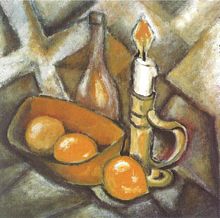Egg tempera

The egg tempera consists of water-thinned egg yolk as a binding agent and a pigment ( tempera painting ). It is considered the "classic" tempera. Their beginnings can be found in early European panel painting.
history
Tempera was already used in ancient times ( mummy portrait ), whether this is also the case for egg tempera is uncertain. It is considered the oldest technique for producing paints and binding them on a picture carrier. For European panel painting, Giotto di Bondone (1267 / 1276–1337) and his school in the 13th century reformed the ancient tempera, which originally consisted of wax and fatty oils, by mixing the pigments only with water-thinned egg yolk. This process had a revolutionary effect and was used almost exclusively by Italian artists until the 14th century. Today it is only used, with a few exceptions, in icon painting and occasionally as an underpainting in panel painting.
Manufacturing
The original, classic egg tempera consists of egg yolk and water. It is described in detail in the "Treatise on Painting", including its application, by Cennino Cennini . Later it was varied by the artists and z. B. made from one part egg (egg white and egg yolk), 1 part linseed oil and 1 part water, used as a painting medium turpentine oil or a dammar solution.
Individual evidence
- ↑ Knut Nicolaus: Investigations on Italian panel painting . In: MALTECHNIK / Restauro . tape 3 , no. 73 + 74 . Callwey, Munich.
- ^ Herrmann Kühn, Heinz Rosen-Runge, Rolf E. Straub and Manfred Koller: Reclam's handbook of artistic techniques . 2nd Edition. Philipp Reclam jun., Stuttgart 1984, ISBN 3-15-010322-3 .
- ^ Cennino Cennini: Il libro dell'arte o trattato della pittura . Ed .: and German transl. Albert Ilg. Osnabrück 1970.
literature
- Ian Jenkins: Greek architecture and its sculpture in the British Museum . London 2006, ISBN 0-7141-2240-8 , pp. 38 .
- Knut Nicolaus: Investigations into Italian panel painting . Callwey Verlag, Munich, special print from MALTECHNIK / Restauro 3/73 + 3/74
- Knut Nicolaus: DuMont's picture lexicon to identify paintings . DuMont book publisher. Cologne 1982. ISBN 3-7701-1243-1
- Kurt Wehlte: Materials and techniques of painting . Stuttgart 2005, ISBN 978-3-332-01665-9 .
- Max Doerner: Painting material and its use in the picture . Stuttgart 2006, ISBN 3-332-01830-2